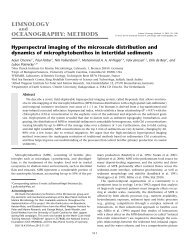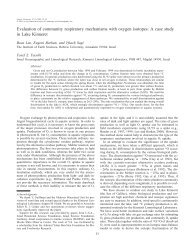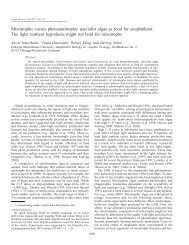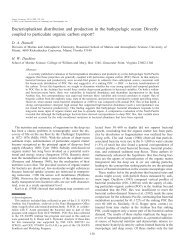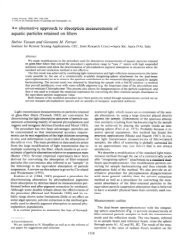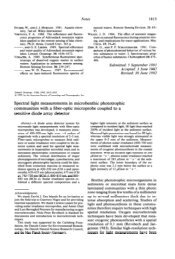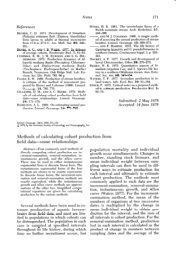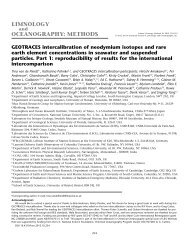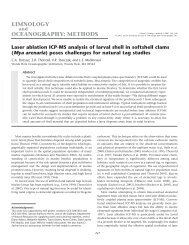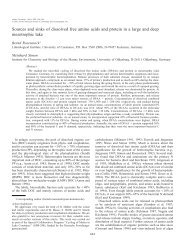Chia Yu Lin and Steven L. Manley. Bromoform production from - ASLO
Chia Yu Lin and Steven L. Manley. Bromoform production from - ASLO
Chia Yu Lin and Steven L. Manley. Bromoform production from - ASLO
Create successful ePaper yourself
Turn your PDF publications into a flip-book with our unique Google optimized e-Paper software.
WORKSHOPS<br />
Workshop 1: Non-Contact Vibration<br />
Characterization<br />
Sunday, August 28, 2011<br />
8:00am–5:00pm Location: Columbia A<br />
Instructors: David Oliver (d.oliver@polytec.com)<br />
Jerome Eichenberger<br />
(j.eichenberger@polytec.com)<br />
Overview:<br />
Laser Doppler vibrometry has been used for non-contact<br />
vibration characterization for several decades by leading<br />
research institutes <strong>and</strong> companies. The technology has<br />
become instrumental in a wide range of applications that include<br />
automotive, aerospace, defense, data storage, micro<br />
electronics (MEMS), ultrasonics <strong>and</strong> medical industries. Noncontact<br />
vibration sensors are being used for basic research,<br />
design development, model verification, process control, <strong>and</strong><br />
to troubleshoot unwanted vibration. A wide variety of laser<br />
Doppler vibrometers are available, each tailored towards specific<br />
needs. Single point vibrometers measure the vibration response<br />
at just one location. Dual beam vibrometers are used to<br />
measure vibrations at two points to remove common mode<br />
vibrations. Rotational vibrometers measure the dynamics of a<br />
rotating shaft or spindles. Among the higher-end systems, 3D<br />
scanning systems are used to measure a tri-axial response <strong>and</strong><br />
map the vibrations across the entire surface of an object.<br />
The morning session of the workshop will be focused on<br />
dynamic characterization of macrostructures (structures ranging<br />
in dimension <strong>from</strong> 1cm to 10s of meters) <strong>and</strong> the afternoon<br />
session will be geared towards microstructure applications.<br />
Each workshop session will consist of two parts: 1) an overview<br />
over the fundamental principles of laser Doppler vibrometry <strong>and</strong><br />
how it integrates seamlessly into the design <strong>and</strong> development<br />
process, <strong>and</strong> 2) a h<strong>and</strong>s-on demonstration on Polytec’s highend<br />
scanning vibrometers.<br />
49<br />
WORKSHOPS<br />
Workshop 2: Mechanical Engineering Design<br />
Knowledge Modeling<br />
Sunday, August 28, 2011<br />
8:00am–5:00pm Location: Columbia B<br />
Instructors: David Rosen (david.rosen@me.gatech.edu)<br />
Joshua Summers (jsummer@clemson.edu)<br />
Overview:<br />
The primary objective of this proposed workshop is to clearly<br />
define the needs <strong>and</strong> develop an outline for a research program<br />
for capturing, representing, <strong>and</strong> modeling mechanical<br />
engineering (ME) design knowledge. The idea is to model<br />
knowledge about ME principles, for instance the conservation<br />
of mass <strong>and</strong> energy, <strong>and</strong> their application to ME devices <strong>and</strong><br />
systems using st<strong>and</strong>ard techniques such as free-body diagrams<br />
or control volumes. Further, the knowledge about how to<br />
formulate models of devices <strong>and</strong> of design decisions should be<br />
modeled. The proposed research program is a much gr<strong>and</strong>er<br />
vision than other NSF sponsored projects <strong>and</strong> programs that<br />
were focused on collecting repositories for artifacts (functions,<br />
geometries, behaviors, etc.). A formalized language of<br />
mechanical engineering is envisioned that will allow engineers to<br />
communicate more precisely between each other <strong>and</strong> with<br />
computers. The resulting formalized ME design knowledge <strong>and</strong><br />
language will be encoded <strong>and</strong> implemented in an openknowledge<br />
repository. Such a knowledge repository could<br />
capture the disparate <strong>and</strong> representationally diverse ME<br />
knowledge of typical undergraduate students providing<br />
numerous benefits: 1) st<strong>and</strong>ard for ME knowledge, 2) a<br />
knowledge base to support engineering design, 3) a knowledge<br />
base for computer-aided tutoring systems, <strong>and</strong> 4) more<br />
generally a key component of the ME research <strong>and</strong> education<br />
infrastructure. When considering the challenges associated<br />
with developing a true Mechanical Engineering modeling<br />
language (MEml), collaboration with many disciplines is<br />
necessary. A convergence of artificial intelligence, engineering<br />
informatics, description logics, <strong>and</strong> the semantic web with<br />
mechanical engineering design research will be the enabling<br />
factor to realize the vision of this research proposal <strong>and</strong><br />
workshop. The workshop is funded by a NSF grant <strong>from</strong> the<br />
Engineering Design program in the CMMI Division.




